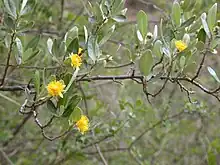| Pineda | |
|---|---|
 | |
| Pineda incana | |
| Scientific classification | |
| Kingdom: | Plantae |
| Clade: | Tracheophytes |
| Clade: | Angiosperms |
| Clade: | Eudicots |
| Clade: | Rosids |
| Order: | Malpighiales |
| Family: | Salicaceae |
| Subfamily: | Salicoideae |
| Tribe: | Prockieae |
| Genus: | Pineda Ruiz & Pav. |
| Type species | |
| Pineda incana Ruiz & Pav. | |
| Species | |
| |
| Synonyms | |
| |
Pineda is a genus of flowering plants in the family Salicaceae. It contains two species of shrubs: Pineda incana, which is native to the Andes of Ecuador and Peru, and Pineda ovata, which is native to the Andes of Bolivia.[1]
Pineda is unique among Salicaceae in that the species have 4-5 sepals and petals, hermaphroditic flowers, receptacular disk glands (=nectaries), and outer filamentous staminodes. It is one of few genera of Salicaceae that occur at high elevations.[1] Formerly placed in the heterogeneous family Flacourtiaceae,[2] Pineda is now classified in tribe Prockieae of Salicaceae, along with close relatives Prockia, Banara, Hasseltiopsis, and Neosprucea.[1]
Pineda was named in honor of Antonio Pineda, a Guatemalan botanist who was coordinator of the naturalists aboard the Pacific expedition of Alessandro Malaspina.[3]
Pineda incana is known as "lloqui," "lloque," "lloquecillos," or "manzanitas cimarronas," and Pineda ovata is known as "duraznillo." Pineda ovata is commonly misidentified as Prockia crucis (Salicaceae).[1]
References
![]() Data related to Pineda at Wikispecies
Data related to Pineda at Wikispecies